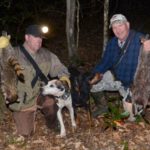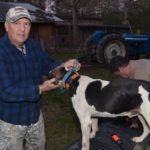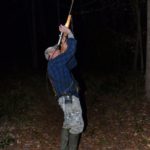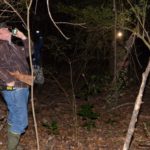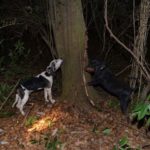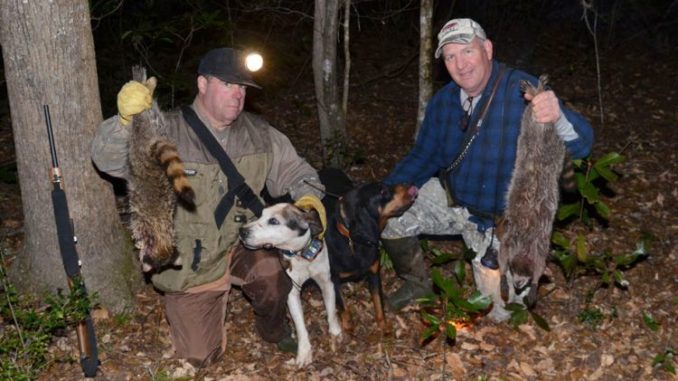
If you’re looking for some old-fashioned fun, chasing coons through the dark of night fits the bill. Here’s what you need to know.
A half-hour before midnight, I threw a look over my shoulder to see if I was dragging a certain piece of my anatomy behind me.
George Ricks was putting a whuppin’ on me. The 57-year-old iron man was making me feel every bit of my 70 years — and he only speeded up when the hounds started yodeling “treed.”
We only needed a couple of coons (raccoons to city folks and biologists) to do our thing. Ricks was to show me how to tan their hides and “musk” them, to be followed by a coon cook-out.
Well before dark, one of Ricks’ regular hunting partners turned up. Fifty-nine-year-old Steve Heurtin was the perfect foil for Ricks: He was lanky, laconic, and slow-talking, while Ricks was strongly built, fast-moving and very talkative.
They even mesh in their hunting. Heurtin keeps a pack of eight to 10 highly trained beagles for rabbit hunting, while Ricks maintains the coon and squirrel dogs.
The hounds knew a hunt was on.
As daylight ebbed, they began howling to go. Ricks selected Blaze (a male treeing walker) and Ruby (a black and tan coonhound).
The men buckled a shock collar on each dog.
“It keeps them honest,” Ricks chuckled.
The first collar was followed by a GPS collar to allow the men to keep track of the dogs and know how far they roamed. A nifty feature on each GPS collar was a mercury switch that triggers an indicator on Ricks’ receiver when the host dog rears up on a tree holding a coon.
Ricks and Heurtin sat on a truck’s tailgate and chatted while they waited for total darkness.
“I like dark nights,” Ricks said. “You tree more coons. On a moony night, you can spot the coon in a tree with no light. But on the other hand, the moon can have a blinding effect from some angles.
“I like to squall once the dogs have treed real solid and I’ve gotten to where I can see most of the tree. Squalling panics a coon and makes it look so you can see his eyes shining in the light.”
It doesn’t always work.
“… (M)any times they won’t look,” Ricks said. “The first squall is the most important — the coon is most likely to look the first time it is called. Squalling sounds like coons fighting.
“The hardest coon to make look is an older, experienced coon that’s been treed and squalled before.”
Ricks does his squalling by mouth, although he said there are a dozen or more brands of commercial coon squallers on the market.
“Coons often jump out of trees after being treed — sometimes from 20 feet up,” he said. “An old coon that has had a bad experience will not tree again that same night.”
Finally deeming it dark enough, the pair set off for a neighbor’s dairy farm five minutes from home. Near home, Ricks hunts on his own or neighbors’ property or on his hunting club’s land.
Favorite destinations when he travels to coon hunt are Tensas River National Wildlife Refuge, Big Lake Wildlife Management Area and Richard K. Yancy Wildlife Management Area, the latter of which he called “some of the finest coon hunting I’ve ever seen.”
Under a crescent sliver of a moon low on the horizon, the two men’s truck bounced through a hay field to the edge of a wooded hollow.
They sent the dogs into the hollow, shouting “get ahead” twice in encouragement.
It was deathly quiet except for the lonesome moan of a diesel locomotive in the distance.
“Doggone it!” Ricks said, breaking the silence. “The dogs went the wrong way in the holler and they’re on the road.”
They jumped in the truck and, using the GPS receiver, zeroed in on the dogs’ location. Every hunter with trained dogs fears losing them to road disease — a speeding car’s bumper.
They loaded the dogs back in the dog box in the truck’s bed and returned to the edge of the field, where they turned them out again.
The dogs hunted silently while the men waited patiently.
Ricks’s eyes were so glued to the GPS receiver’s screen that he missed the overhead show. The moon had set, and billions of stars glittered like screaming diamonds through the trees overhead.
A strong cold had pushed out all the haze and clouds two days before, and the air was crystalline.
The dogs came out of the hollow again, so they had to round them up a second time.
“Well, we got off to a slow start, but we’ll get it going,” Ricks said confidently.
Next stop was in the Tangipahoa River bottom east of Kentwood.
Gentry Gill, one of the owners of the land and a sometime coon hunting partner of Ricks, joined the two men in the moist bottom before they let the dogs out.
Heurtin and Gill followed single file behind Ricks, the beams of their lights bouncing off tree trunks. The air was fresh and cool.
Five hundred yards away, the dogs opened up and treed almost immediately, baying franticly. The deep belling of Ruby and the chop of Blaze were noticeably different.
It was off to the races — through the green hell of privet thickets laced with thorny saw briar vines, through a creek and over several old, rusty barbed wire fences drooping to ankle height like booby traps.
The dogs were treed on a modest oak tree. Rick’s squalled angrily and Heurtin yanked on a muscadine vine in an attempt to make the coon move.
Because they could see the entire leafless tree, they quickly concluded it held no coons.
They pulled the dogs off 50 yards and re-cast them. In five minutes, Ruby opened up on a trail, and in a jiffy both dogs were treed 75 yards away, up a pin oak of similar size to the previous one.
The men circled round and round the tree, but just couldn’t see the coon, if there was one. They gave up, called the dogs off, and cast them loose again.
This time the hounds headed due north, followed by the hunters busting through thick brush for a half mile. The hunting party turned around and smashed through the jungle back to the truck.
Ricks piloted the vehicle, while simultaneously following the dogs’ progress on his GPS. His goal was to cut them off on a road 2 miles away.
“I can’t figure out what’s going on,” he muttered in frustration. “How could the dogs go that far without cutting a track?”
They stopped the truck at the projected cut-off point, got out and listened in the darkness.
They could hear Blaze open up once in a while, but Ruby was silent as they ran in circles on the GPS screen.
“I don’t think bad about my dogs, but I think they are running a coyote,” Ricks grunted.
He watched the screen a little more.
“I’m convinced that they are running trash,” he muttered. “I’m going to go in and get them. They are only 200 yards away.”
Still no coon for our efforts.
He drove to his personal property near his retreat, “Camp Corn Cob,” a mile from his home.
“Let’s make one last try,” Ricks said.
After they turned the dogs out in a hardwood creek bottom surrounded by pine uplands, the party was reduced by one as Gill decided going to bed was his best option.
Again, Ruby’s clear bell voice rang out. A half-mile scramble through the dense forest brought us to the tree.
Both dogs were going wild, frantically barking up the tree. The men took positions on opposite sides of the tree and scanned it with their lights.
“I believe I see two coons,” Ricks said.
With a single shot from the .22 rifle, a coon came crashing down through the brush and hit the ground with a thud.
The dogs pounced on its carcass immediately, mauling it unmercifully.
“He’s dead; he’s dead,” Ricks commanded the dogs, as he took it away from them and hung it out of their reach in a tree crotch 7 feet off the ground.
“I see the other one,” Heurtin declared.
This one was bigger and wouldn’t show an eye to the lights. Unfortunately for it, its striped tail hung like a flag.
Ricks took it down with a single shot, as well.
It was just before midnight, and we had our two coons to tan and eat. We began the long hike through the bottom and over the ridge back to the truck.
They got so far ahead of me that I could barely see their bobbing lights.
When I got to the truck, Ricks — with a twinkle in his grey eyes — delivered a massive understatement.
“Coon hunting is good exercise,” he said.
Choose the right dog
There are many choices of coonhounds, so which one is best? Log onto LouisianaSportsman.com/best-coon-dogs to find out.
Steps to tanning hides
Tanning your coon hides — or any hide, for that matter — is possible. You just need to know the steps, which can be found at LouisianaSportsman.com/how-to-tan-a-coon.
Learn how to skin a coon
For a step-by-step pictorial of how to skin a raccoon, just jump online at LouisianaSportsman.com/how-to-skin-coons.
